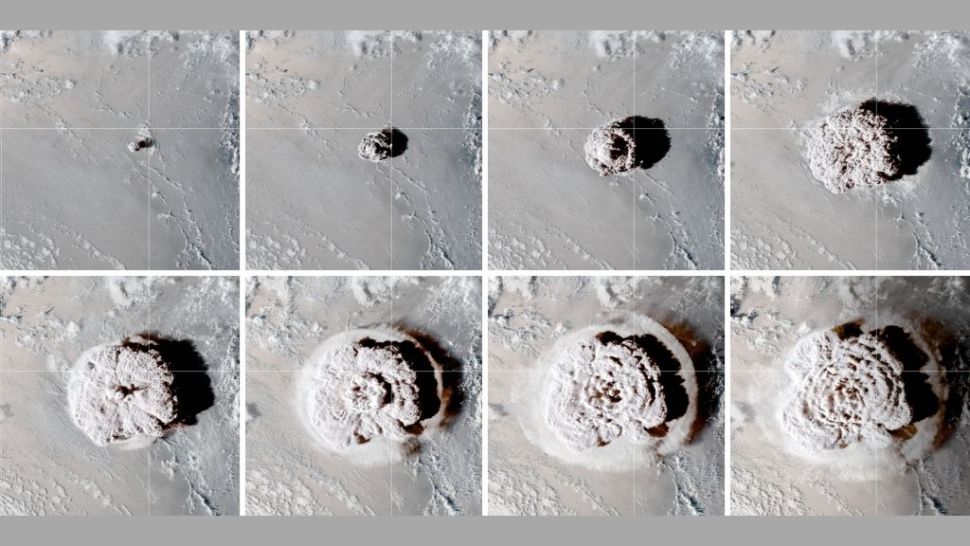Tonga underwater volcano eruption shattered two records
The Hunga Tonga-Hunga Ha'apai volcano erupted last month.

An underwater volcano in the South Pacific erupted last month and shattered two records simultaneously: The volcanic plume reached greater heights than any eruption ever captured in the satellite record, and the eruption generated an unparalleled number of lightning strikes — almost 590,000 over the course of three days, Reuters reported.
"The combination of volcanic heat and the amount of superheated moisture from the ocean made this eruption unprecedented. It was like hyper-fuel for a mega-thunderstorm," Kristopher Bedka, an atmospheric scientist at NASA's Langley Research Center who specializes in studying extreme storms, said in a statement from the NASA Earth Observatory. "The plume went 2.5 times higher than any thunderstorm we have ever observed, and the eruption generated an incredible amount of lightning."
The volcano, called Hunga Tonga-Hunga Ha'apai, lies about 40 miles (65 kilometers) north of the Tongan capital of Nuku'alofa and sits within the so-called Tonga-Kermadec volcanic arc, a line of mostly underwater volcanoes that runs along the western edge of the Pacific Plate of Earth's crust, Nature magazine reported.
Related: Elves, sprites & blue jets: Earth's weirdest lightning
The eruption began on Jan. 13, launching explosions that broke the water's surface and generating a major lightning event, according to Reuters. Then, on Jan. 15, rising magma from Hunga Tonga-Hunga Ha'apai met the seawater above the volcano, triggering a sudden and massive blast. Such explosive eruptions can occur when magma rapidly heats water into steam, which then quickly expands; bubbles of volcanic gas caught within the magma also help to drive these dramatic blasts up and out of the water, Nature reported.
Underwater volcanic eruptions don't typically release large plumes of gas and particles into the air, but the Jan. 15 eruption was an exception to this rule, Nature reported.
Two weather satellites — the National Oceanic and Atmospheric Administration's Geostationary Operational Environmental Satellite 17 (GOES-17) and the Japan Aerospace Exploration Agency's Himawari-8 — captured the unusual eruption from above, allowing scientists at NASA's Langley Research Center to calculate just how far the plume penetrated the atmosphere.
Get the Space.com Newsletter
Breaking space news, the latest updates on rocket launches, skywatching events and more!
"From the two angles of the satellites, we were able to recreate a three-dimensional picture of the clouds," Konstantin Khlopenkov, a scientist on the NASA Langley team, said in the statement.
Related: 10 incredible volcanoes in our solar system
They determined that, at its highest point, the plume rose 36 miles (58 km) into the air, meaning it pierced the mesosphere — the third layer of the atmosphere — according to the NASA statement. After an initial blast generated this towering plume, a secondary blast from the volcano sent ash, gas and steam more than 31 miles (50 km) into the air.
Back in 1991, Mount Pinatubo in the Philippines unleashed a plume that extended 22 miles (35 km) above the volcano, and until the recent Hunga Tonga-Hunga Ha'apai eruption, that 1991 event held the record for the largest known volcanic plume in the satellite record, the statement noted.
When the highest portions of these plumes reached the mesosphere, they quickly transitioned into a gaseous state. But in the stratosphere below, gas and ash from the volcano accumulated and spread to cover an area of 60,000 square miles (157,000 square kilometers).

"As the eruption plume hit the stratosphere and spread outward, it appears to have created waves in the atmosphere," Chris Vagasky, a meteorologist at Vaisala, an environmental technology company, told Reuters. Vagasky and his colleagues are still studying the lightning activity generated by the eruption, and he's interested in how these atmospheric waves influenced the pattern of lightning strikes.
To study the lightning, the team is using data from GLD360, a ground-based lightning detection network operated by Vaisala. These data revealed that, of the nearly 590,000 lightning strikes that took place during the eruption, about 400,000 occurred within six hours after the big blast on Jan. 15, Reuters reported.
Prior to the Tonga eruption, the largest volcanic lightning event in Vaisala's records happened in Indonesia in 2018, when Anak Krakatau erupted and generated about 340,000 lightning strikes over the course of a week. "To detect nearly 400,000 in just a few hours is extraordinary," Vagasky told Reuters. About 56% of the lightning struck the surface of the land or ocean, and more than 1,300 strikes landed on Tonga's main island of Tongatapu, the team determined.
The lightning came in two flavors. One type of lightning was caused by "dry charging," in which ash, rocks and lava particles repeatedly collide in the air and swap negatively charged electrons. The second type of lightning was caused by "ice charging," which occurs when the volcanic plume reaches heights where water can freeze and form ice particles that slam into each other, Reuters reported.
Both of these processes lead to lightning strikes by causing electrons to build up on the undersides of the clouds; these negatively charged particles then leap to higher, positively charged regions of the clouds or to positively charged regions of the ground or sea below.
"The percentage of lightning that was classified as cloud-to-ground was higher than you would normally see in a typical thunderstorm and higher than you typically see in volcanic eruptions, so that creates some interesting research questions," Vagasky told Reuters.
Originally published on Live Science.
Join our Space Forums to keep talking space on the latest missions, night sky and more! And if you have a news tip, correction or comment, let us know at: community@space.com.

Nicoletta Lanese is a staff writer for Live Science covering health and medicine, along with an assortment of biology, animal, environment and climate stories. She holds degrees in neuroscience and dance from the University of Florida and a graduate certificate in science communication from the University of California, Santa Cruz. Her work has appeared in The Scientist Magazine, Science News, The San Jose Mercury News and Mongabay, among other outlets.










